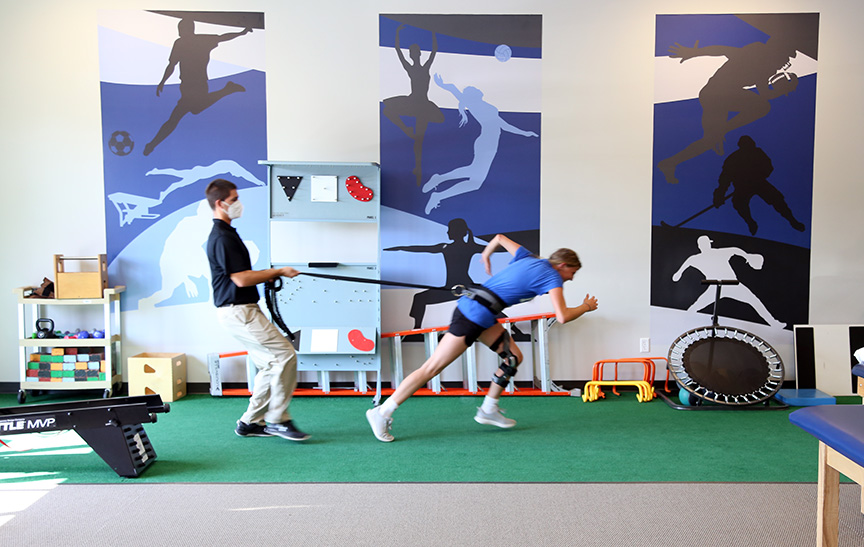News
Dry Needling Options for Knee Osteoarthritis
By Jessica Woodward
A skeletal muscle’s purpose is to maintain posture, move bones, protect joints, and provide joint stability. What happens to the surrounding skeletal muscle when a joint becomes arthritic? The muscles become directly affected, typically causing trigger points to develop and myofascial pain syndrome can occur. Research indicates dry needling to be beneficial for treating muscular trigger points. Trigger points can develop in the gastrocnemius, quadriceps, popliteus, tensor fasciae latae, hip adductors, and hamstrings in the knee osteoarthritis (OA) population.4
Combined with specific exercise, dry needling for the muscles being affected due to knee OA has been shown to be beneficial for these patients’ pain levels in the short term, but the results are contradictory. Knee OA is more of a structural issue, and therefore the research is divided on whether it is helpful to utilize intramuscular dry needling in rehabilitation.3,2 Other knee conditions such as, patellofemoral syndrome, have more promising results with short and long-term regarding pain and function with dry needling. Patellofemoral pain syndrome is primarily a motor control derived pathology, and thus responds to exercise and dry needling best vs. exercise alone. More recently, researchers have been asking the question of “Is there another dry needling approach to the knee OA population that would be more beneficial than intramuscular dry needling?”
Studies are now showing sufficient evidence with dry needling involving periosteal bone stimulation for a variety of arthritic conditions. The thought process behind periosteal stimulation is to stimulate healthy blood flow to promote a natural healing response to the degenerative tissue by stimulating osteoblastic production. In dry needling with periosteal stimulation, both electrical dry needling and periosteal bone tapping has been shown to be advantageous. Specifically, these studies have been shown to reduce T2 signal on MRI, stimulate hyaluronic acid production, reduce interleukin-6 mRNA expression in bone marrow, and decrease plasma cortisol levels.1, 5 Multiple studies support the use of periosteal bone stimulation with dry needling for mild to moderate knee osteoarthritis. Subjectively, pain levels and the patients’ perceived disability were statistically improved at both 4 days, and up to 1 month from their dry needling treatment combined with exercise.5 Overall, the application of periosteal bone stimulation through dry needling should be considered as an additional treatment received in physical therapy practice for the knee OA population.
Research continues to be performed in physical therapy, analyzing the efficacy of dry needling, and recently more specific to periosteal bone stimulation. At this time more research needs to be completed for the long-term effects of this type of treatment. Specific parameters also need to be established for practicing clinicians to follow. If physicians and physical therapists work together to individualize each patient’s treatment according to their symptoms, physical assessments, and imaging; dry needling should be considered in knee osteoarthritis rehabilitation.
At St. Elizabeth Sports and Physical Therapy we offer dry needling services at multiple locations with certified physical therapists who are ready to assist your patients with individualized care. We have five clinics located conveniently throughout Lincoln with hour long treatment sessions. Please consider one of our clinics with your knee OA patients who are ready to regain their mobility.
Works Cited
Dunning, James, et al. “Periosteal Electrical Dry Needling as an Adjunct to Exercise and Manual Therapy for Knee Osteoarthritis.” The Clinical Journal of Pain, vol. 34, no. 12, 2018, pp. 1149–1158, https://doi.org/10.1097/ajp.0000000000000634.
Rahou-El-Bachiri, Youssef, et al. “Effects of Trigger Point Dry Needling for the Management of Knee Pain Syndromes: A Systematic Review and Meta-Analysis.” Journal of Clinical Medicine, vol. 9, no. 7, 2020, p. 2044, https://doi.org/10.3390/jcm9072044.
Sánchez Romero, Eleuterio A, Josué Fernández-Carnero, et al. “Is a Combination of Exercise and Dry Needling Effective for Knee OA?” Pain Medicine, 2019, https://doi.org/10.1093/pm/pnz036.
Sánchez Romero, Eleuterio A., Josué Fernández Carnero, et al. “Prevalence of Myofascial Trigger Points in Patients with Mild to Moderate Painful Knee Osteoarthritis: A Secondary Analysis.” Journal of Clinical Medicine, vol. 9, no. 8, 2020, p. 2561, https://doi.org/10.3390/jcm9082561.
Ughreja, Reepa A., and V. Prem. “Effectiveness of dry needling techniques in patients with knee osteoarthritis: A systematic review and meta-analysis.” Journal of Bodywork and Movement Therapies, vol. 27, 2021, pp. 328–338, https://doi.org/10.1016/j.jbmt.2021.02.015.
Wang, Xuewei, et al. “Electrical Dry Needling Plus Corticosteroid Injection for Osteoarthritis of the Knee: A Randomized Controlled Trial.” Archives of Physical Medicine and Rehabilitation, vol. 103, no. 5, 2022, pp. 858–866, https://doi.org/10.1016/j.apmr.2021.12.026.
